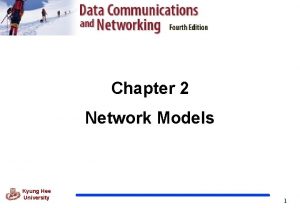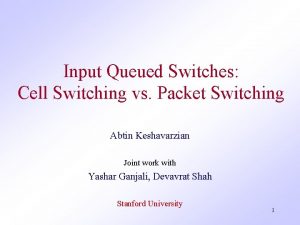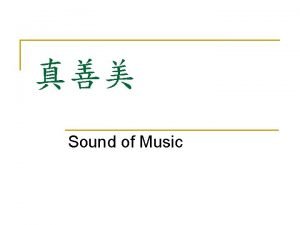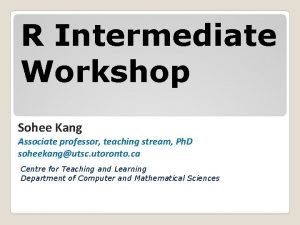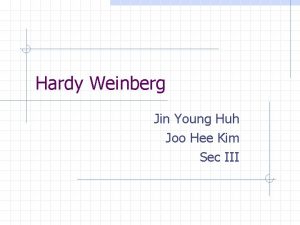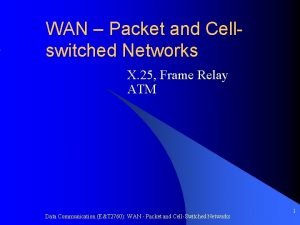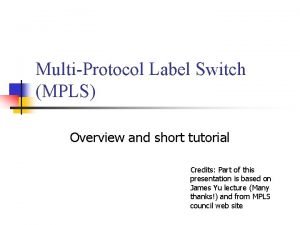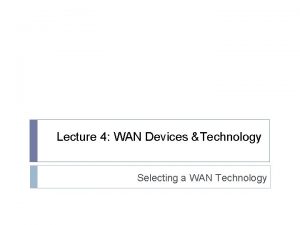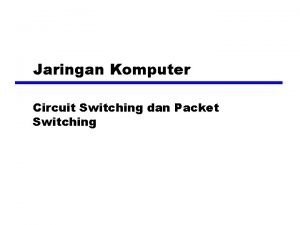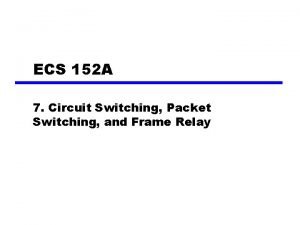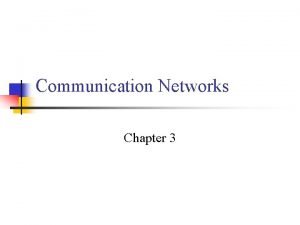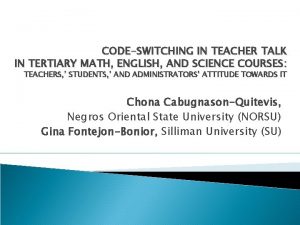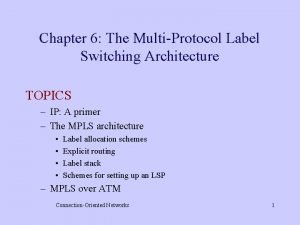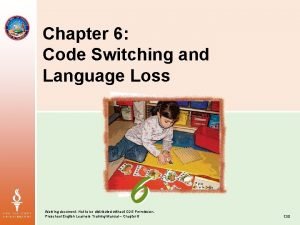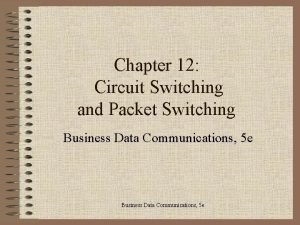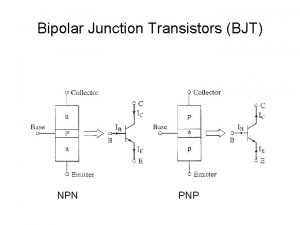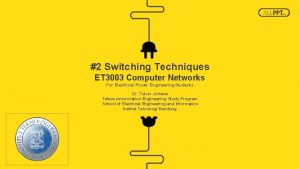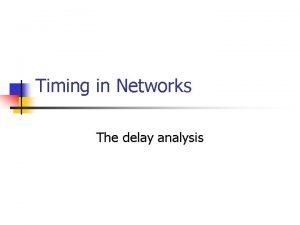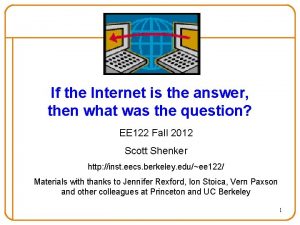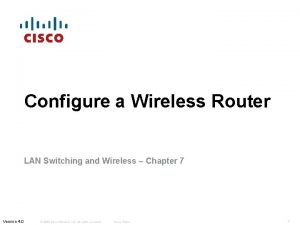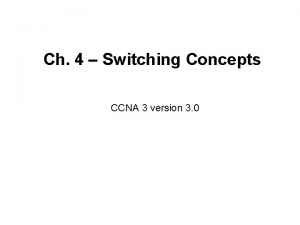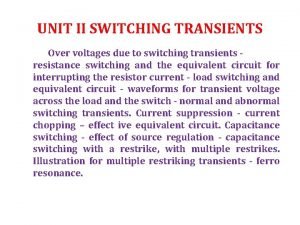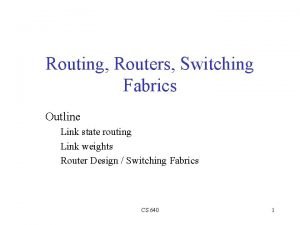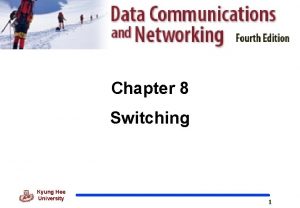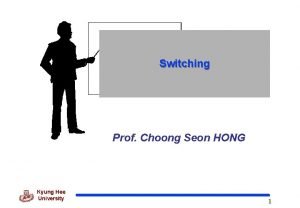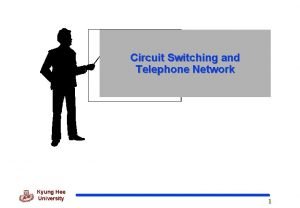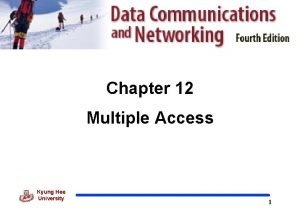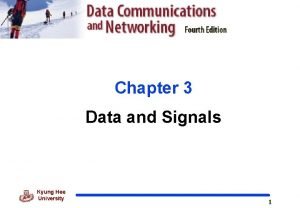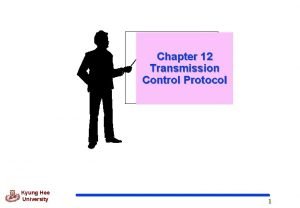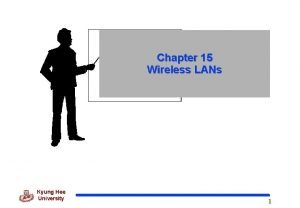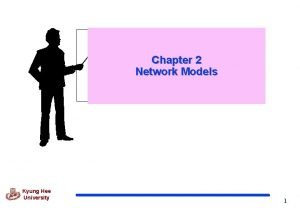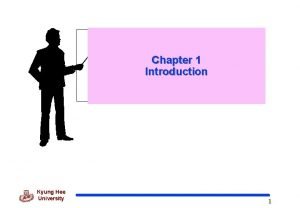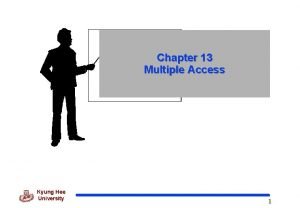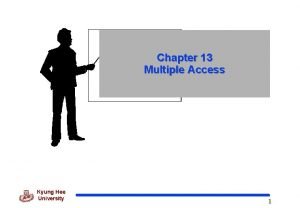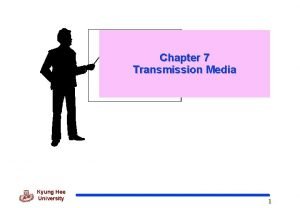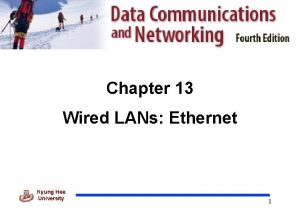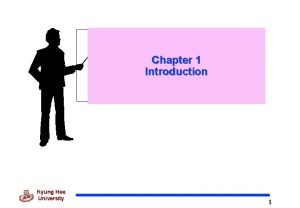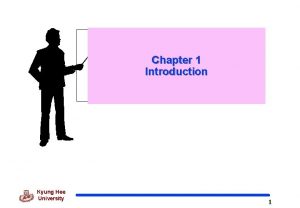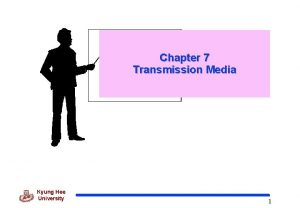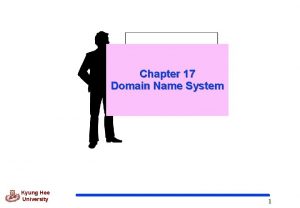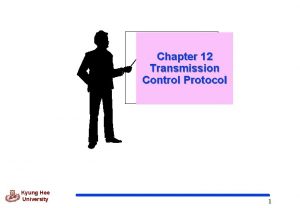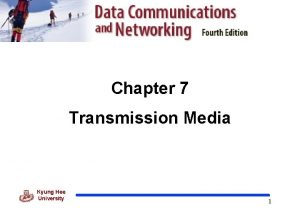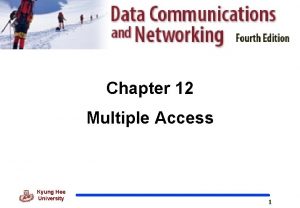Chapter 8 Switching Kyung Hee University 1 Switching
































































- Slides: 64

Chapter 8 Switching Kyung Hee University 1

Switching q. Switching v. Switches are devices capable of creating temporary connections between two or more devices linked to the switch. Kyung Hee University 2

Figure 8. 2 Taxonomy of switched networks Kyung Hee University 3

8 -1 CIRCUIT-SWITCHED NETWORKS A circuit-switched network consists of a set of switches connected by physical links. A connection between two stations is a dedicated path made of one or more links. However, each connection uses only one dedicated channel on each link. Each link is normally divided into n channels by using FDM or TDM. Topics discussed in this section: Three Phases Efficiency Delay Circuit-Switched Technology in Telephone Networks Kyung Hee University 4

Figure 8. 3 A trivial circuit-switched network Kyung Hee University 5

A trivial circuit-switched network q. When end system A needs to communicate with sys. M v. Setup Phase ; System A needs to request a connection to M that must be accepted by all switches as well as by M itself. l A channel is reserved on each link, and the combination of channels defines the dedicated path. v. Data transfer ; After the dedicated path made of connected channels is established, data transfer can take place. v. Teardown Phase ; After all data have been transferred, the circuits are torn down. Kyung Hee University 6

Note In circuit switching, the resources need to be reserved during the setup phase; the resources remain dedicated for the entire duration of data transfer until the teardown phase. Kyung Hee University 7

Example 8. 1 As a trivial example, let us use a circuit-switched network to connect eight telephones in a small area. Communication is through 4 -k. Hz voice channels. We assume that each link uses FDM to connect a maximum of two voice channels. The bandwidth of each link is then 8 k. Hz. Figure 8. 4 shows the situation. Telephone 1 is connected to telephone 7; 2 to 5; 3 to 8; and 4 to 6. Of course the situation may change when new connections are made. The switch controls the connections. Kyung Hee University 8

Figure 8. 4 Circuit-switched network used in Example 8. 1 Kyung Hee University 9

Example 8. 2 As another example, consider a circuit-switched network that connects computers in two remote offices of a private company. The offices are connected using a T-1 line leased from a communication service provider. There are two 4 × 8 (4 inputs and 8 outputs) switches in this network. For each switch, four output ports are folded into the input ports to allow communication between computers in the same office. Four other output ports allow communication between the two offices. Figure 8. 5 shows the situation. Kyung Hee University 10

Figure 8. 5 Circuit-switched network used in Example 8. 2 Kyung Hee University 11

Three Phase q As in a circuit-switched network, a source and destination need to go through three phases in a virtual-circuit network; set-up, data transfer, and teardown. v. Set-up phase l l Suppose source A needs to create a virtual circuit to B. Two steps are required; set-up & acknowledgement. v. Data transfer phase l The data transfer phase is active until the source sends all its frames to the destination. v. Teardown phase l l l Source A, after sending all frames to B, send a special frame called a teardown request. Destination B responds with a teardown confirmation frame. All switches delete the corresponding entry from their table. Kyung Hee University 12

Efficiency & delay q. Efficiency v Circuit switched networks are not as efficient as the other two types of networks because resources are allocated during the entire duration of the connection. v. These resources are unavailable to other connections. q. Delay v Although a circuit-switched network normally has low efficiency, the delay in this type of network is minimal. v. During data transfer the data are not delayed at each switch; the resources are allocated for the duration of the connection. Kyung Hee University 13

Figure 8. 6 Delay in a circuit-switched network Kyung Hee University 14

Note Switching at the physical layer in the traditional telephone network uses the circuit-switching approach. Kyung Hee University 15

8 -2 DATAGRAM NETWORKS In data communications, we need to send messages from one end system to another. If the message is going to pass through a packet-switched network, it needs to be divided into packets of fixed or variable size. The size of the packet is determined by the network and the governing protocol. Topics discussed in this section: Routing Table Efficiency Delay Datagram Networks in the Internet Kyung Hee University 16

Note In a packet-switched network, there is no resource reservation; resources are allocated on demand. Kyung Hee University 17

Datagram network q In datagram network, each packet is treated independently of all others. v Even if a packet is part of a multipacket transmission, the network treats it as though it existed alone. Figure 8. 7 A datagram network with four switches (router) Kyung Hee University 18

Routing table Figure 8. 8 Routing table in a datagram network A switch in a datagram network uses a routing table that is based on the destination address. Kyung Hee University 19

Note The destination address in the header of a packet in a datagram network remains the same during the entire journey of the packet. The efficiency of a datagram network is better than that of a circuit-switched network; resources are allocated only when there are packets to be transferred. Kyung Hee University 20

Delay q There may be greater delay in a datagram network than in a virtual-circuit network. v Total delay = 3 T + 3 זּ + w 1 + w 2 Where, T=Transmission time, = זּ Propagation delay, w=Waiting time Figure 8. 9 Delay in a datagram network Kyung Hee University 21

Note Switching in the Internet is done by using the datagram approach to packet switching at the network layer. Kyung Hee University 22

8 -3 VIRTUAL-CIRCUIT NETWORKS A virtual-circuit network is a cross between a circuitswitched network and a datagram network. It has some characteristics of both. Topics discussed in this section: Addressing Three Phases Efficiency Delay Circuit-Switched Technology in WANs Kyung Hee University 23

Virtual-Circuit Network q Characteristics of Virtual-circuit network v. As in a circuit-switched network, there are setup and teardown phases in addition to the data transfer phase. v. Resources can be allocated during the setup phase, as in a circuit -switched network, or on demand, as in a datagram network. v. As in a datagram network, data are packetized and each packet carries an address (local jurisdiction) in the header. v. As in a circuit network, all packets follow the same path established during the connection. v. A virtual-circuit network is normally implemented in the data link layer, while a circuit-switched network is implemented in the physical layer and a datagram network in the network layer. Kyung Hee University 24

Virtual-Circuit Network q The virtual-circuit network has switches that allow traffic from sources to destinations. q A source or destination can be a computer, packet switch, or other device that connects other network. Figure 8. 10 Virtual-circuit network Kyung Hee University 25

Global Addressing q In virtual circuit networks, v A global address that can be unique in the scope of the WAN or international network. v global addressing in virtual circuit networks is used only to create a virtual circuit identifier. Kyung Hee University 26

Virtual Circuit Identifier (VCI) q VCI is actually used for data transfer. q VCI (Virtual Circuit Identifier) v is a small number that only has switch scope, v it is used by a frame between two switches. q Each switch can use its own unique set of VCIs Kyung Hee University 27

Three Phases q To communicate, a source and destination need to go through three phases v 설정(setup), Kyung Hee University 데이터전송(data transfer), 해제(teardown) 단계 28

Three Phases q In the setup phase, the source and destination use their global addresses to help switches make table entries for the connection. q In the teardown phase, the source and destination inform the switches to erase the corresponding entry. q Data phase occurs between these two phases. Kyung Hee University 29

Data Transfer Phase q To transfer a frame from a source to its destination, all switches need to have a table entry for this virtual circuit. Kyung Hee University 30

Data Transfer Phase (cont’d) q Source-to-destination data Transfer Kyung Hee University 31

Setup Phase q How does a switch create an entry for a virtual circuit? v. Switched virtual circuit (SVC) approach l Suppose source A needs to create a virtual circuit to B. l Two steps are required; – Kyung Hee University the setup request and the acknowledgment. 32

Switched Virtual Circuit (SVC) q Creating temporary and short connection that exists only when data are being transferred between source and destination. q Setup request VCI (77) lets the destination know that the frames come from A and not other sources Kyung Hee University 33

SVC (cont’d) q SVC setup acknowledgment Kyung Hee University 34

Teardown Phase q In this phase, source A, after sending all frames to B, sends a special frame called a teardown request. q Destination B responds with a teardown confirmation frame. q All switches erase the corresponding entry from their tables. Kyung Hee University 35

Efficiency Note In virtual-circuit switching, all packets belonging to the same source and destination travel the same path; but the packets may arrive at the destination with different delays if resource allocation is on demand. Kyung Hee University 36

Delay in Virtual-circuit networks q There is a one-time delay for setup and a one-time delay for teardown. q If resources are allocated during the setup phase, there is no wait time for individual packets. q Total delay time = 3 T + 3 זּ + setup delay + teardown time Kyung Hee University 37

Note Switching at the data link layer in a switched WAN is normally implemented by using virtual-circuit techniques. Kyung Hee University 38

8. 4 STRUCTURE OF A SWITCH We use switches in circuit-switched and packet-switched networks. In this section, we discuss the structures of the switches used in each type of network. Topics discussed in this section: Structure of Circuit Switches Structure of Packet Switches Kyung Hee University 39

Circuit Switching(cont’d) q. Structure of Circuit Switching ~ can use either two technologies. q. Switching Kyung Hee University 40

Circuit Switching(cont’d) q. Space-Division Switches vthe paths in the circuit are separated from each other spatially(crossbar switch) q. Crossbar switch ~ connect n input to m output in a grid, using electronic microswitch(transistor) at each crosspoint. Kyung Hee University 41

Circuit Switching(cont’d) Figure 8. 17 Crossbar switch with three inputs and four outputs Kyung Hee University 42

Circuit Switching(cont’d) q. Limitation of crossbar switch v. The number of switch (huge size) : connect n inputs by m output l require n * m crosspoint. (ex : 1000 input, 1000 output → 1, 000 crosspoint) vinefficient l fewer than 25% of the crosspoints are in use at a given time. l the rest are idle Kyung Hee University 43

Circuit Switching(cont’d) q. Multistage switch ~ combines crossbar switches in several (normally three) stages to solve the limitation of the crossbar switch. Figure 8. 18 Multistage switch Kyung Hee University 44

Circuit Switching(cont’d) q. Multistage switch Note In a three-stage switch, the total number of crosspoints is 2 k. N + k(N/n)2 which is much smaller than the number of crosspoints in a single-stage switch (N 2). Kyung Hee University 45

Example 8. 3 Design a three-stage, 200 × 200 switch (N = 200) with k = 4 and n = 20. Solution In the first stage we have N/n or 10 crossbars, each of size 20 × 4. In the second stage, we have 4 crossbars, each of size 10 × 10. In the third stage, we have 10 crossbars, each of size 4 × 20. The total number of crosspoints is 2 k. N + k(N/n)2, or 2000 crosspoints. This is 5 percent of the number of crosspoints in a single-stage switch (200 × 200 = 40, 000). Kyung Hee University 46

Example 8. 3 l N=200, n=20, k=4 Ø 1 st stage ; No. of switches N/n = 200/20 = 10, each of size = n x k =20 x 4 Ø 2 nd stage ; No. of switches k = 4, each of size = N/n x N/n = 10 x 10 Ø 3 rd stage ; No. of switches N/n = 200/20 = 10, each of size = k x n = 4 x 20 l Total No. of cross points ; 10(20 x 4) + 4(10 x 10) + 10(4 x 20) = 2, 000 or 2 k. N + k(N/n) 2 = 2 x 4 x 200 + 4(200/20)2 =2, 000 v This is 5% of the No. of crosspoints in a single-stage switch (200 x 200 = 40, 000) Kyung Hee University 47

Clos Criterion q. The multistage switch has one drawback-blocking. v. Blocking refers to times when one input cannot be connected to output because there is no path available between them. v. Clos investigated the condition of nonblocking in multi-stage switches and came up with the following formula. According to the Clos criterion: Ø n = (N/2)1/2 Ø middle-stage switches must be at least k > 2 n – 1 v Crosspoints ≥ 4 N [(2 N)1/2 – 1] Kyung Hee University 48

Example 8. 4 Redesign the previous three-stage, 200 × 200 switch, using the Clos criteria with a minimum number of crosspoints. Solution We let n = (200/2)1/2, or n = 10. We calculate k = 2 n − 1 = 19. In the first stage, we have 200/10, or 20, crossbars, each with 10 × 19 crosspoints. In the second stage, we have 19 crossbars, each with 20 × 20 crosspoints. In the third stage, we have 20 crossbars each with 19 × 10 crosspoints. The total number of crosspoints is 20(10 × 19) + 19(20 × 20) + 20(19 × 10) = 15, 200. Kyung Hee University 49

Example 8. 4 l N=200, n= (N/2)2 = (200/2)2 =10, k=(2 n-1) = (2 x 10 -1) = 19 Ø 1 st stage ; No. of switches N/n = 200/10 = 20, each of size = n x k =10 x 19 Ø 2 nd stage ; No. of switches k = 19, each of size = N/n x N/n = 20 x 20 Ø 3 rd stage ; No. of switches N/n = 200/10 = 20, each of size = k x n = 19 x 10 l Total No. of cross points ; 20(10 x 19) + 19(20 x 20) + 20(19 x 10) = 15, 200 or 4 N {(2 N)1/2 -1}= 4 x 200 {(2 x 200)1/2 -1}= 15, 200 v This is 38% of the No. of crosspoints in a single-stage switch (200 x 200 = 40, 000) v More points are needed than in Ex. 8. 3 (5%) v The extra crosspoints are needed to prevent blocking. Kyung Hee University 50

Circuit Switching(cont’d) q. Time-Division Switch v uses Time-division multiplexing (TDM) inside a switch. v The most popular technology is called the time-slot interchange (TSI). l TSI changes the ordering of the slots based on the desired connections. Kyung Hee University 51

Circuit Switching(cont’d) q. Time-division multiplexing without a time-slot interchange(TSI) Kyung Hee University 52

Circuit Switching(cont’d) q. Time-division multiplexing with a time-slot interchange(TSI) Kyung Hee University 53

Circuit Switching(cont’d) q. TSI 동작과정 Figure 8. 19 Time-slot interchange Kyung Hee University 54

Circuit Switching(cont’d) q. Space-and Time-Division Switching Combinations ~ combine space-division and time-division technology to take advantage of the best of both v. TST(time-space-time) v. TSST(time-space-time) v. STTS(space-time-space) Kyung Hee University 55

Circuit Switching(cont’d) Figure 8. 20 Time-space-time switch Kyung Hee University 56

Structure of Packet switches q A switch used in a packet-switched network has a different structure from a switch used in a circuit-switched network. q A packet switch has four components; v input ports, output ports, the routing processor, and the switching fabric. Figure 8. 21 Packet switch components Kyung Hee University 57

Structure of Packet switches Figure 8. 22 Input port q An input port performs the physical and data link functions of the packet switch. Kyung Hee University 58

Structure of Packet switches Figure 8. 23 Output port q An output port performs the same functions as the input port, but in the reverse order. Kyung Hee University 59

Structure of Packet switches q Routing Processor v. The routing processor performs of the network layer. q Switching fabrics v. The most difficult task in a packet switch is to move the packet from the input queue to the output queue. v. Today, packet switches are specialized mechanisms that use a variety of switching fabrics. l Crossbar switch : Simplest type of switching fabric is the crossbar switch. Kyung Hee University 60

Structure of Packet switches Figure 8. 24 A banyan switch q A banyan switch is a multistage switch with microswitches at each stage that route the packets based on the output port represented as a binary string. Kyung Hee University 61

Structure of Packet switches Figure 8. 25 Examples of routing in a banyan switch Kyung Hee University 62

Structure of Packet switches Figure 8. 26 Batcher-banyan switch q Batcher-banyan switch has designed to solve the problem of banyan switch that comes before the banyan switch and sorts the incoming packets according to their final destination. Kyung Hee University 63

Q&A Kyung Hee University 64
 Kyung hee university mba
Kyung hee university mba Kyung hee university hospital at gangdong
Kyung hee university hospital at gangdong Html q
Html q Address cont'd
Address cont'd Circuit switching vs packet switching vs message switching
Circuit switching vs packet switching vs message switching Difference between datagram and virtual circuit
Difference between datagram and virtual circuit Cell switching vs packet switching
Cell switching vs packet switching Advantages and disadvantages of circuit switching
Advantages and disadvantages of circuit switching Packet switching vs circuit switching
Packet switching vs circuit switching Cell switching vs packet switching
Cell switching vs packet switching Captain kyung
Captain kyung Out of programme pause
Out of programme pause Tan hee juan v the boon keat
Tan hee juan v the boon keat Horus portfolio
Horus portfolio Horus.hee
Horus.hee Lau hee teah v hargill engineering sdn bhd
Lau hee teah v hargill engineering sdn bhd D
D Yhkim
Yhkim Hee chang trading co., ltd.
Hee chang trading co., ltd. Tan hee juan v the boon keat
Tan hee juan v the boon keat Hee joo lee
Hee joo lee Https://www.youtube.comwatch
Https://www.youtube.comwatch So-hee kang utsc
So-hee kang utsc Professor cheong hee kiat
Professor cheong hee kiat Horus hee
Horus hee Secondary 3 streaming
Secondary 3 streaming Joo hee jin
Joo hee jin 詹景裕
詹景裕 Wan packet switching
Wan packet switching Teknik switching
Teknik switching Benes network
Benes network Cell cycle analysis
Cell cycle analysis Multiprotocol label switching tutorial
Multiprotocol label switching tutorial Each packet is treated independently
Each packet is treated independently Private wan technologies
Private wan technologies Circuit switched networks
Circuit switched networks Circuit switched wan
Circuit switched wan Circuit switching in networking
Circuit switching in networking Packet switching principles
Packet switching principles Circuit switching types
Circuit switching types What are the types of code switching
What are the types of code switching Examples of code switching
Examples of code switching Multiprotocol label switching architecture
Multiprotocol label switching architecture Code switching definition
Code switching definition Data link layer switching in computer networks
Data link layer switching in computer networks Circuit switching types
Circuit switching types Bjt switch
Bjt switch What is code-switching in language
What is code-switching in language Code switching definition
Code switching definition Switching techniques in computer networks
Switching techniques in computer networks Circuit switching timing diagram
Circuit switching timing diagram Code switching in sociolinguistics
Code switching in sociolinguistics Routing switching adalah
Routing switching adalah Cell switching in computer networks
Cell switching in computer networks Tag switching example
Tag switching example Switching network
Switching network Switching overvoltages in ehv and uhv systems
Switching overvoltages in ehv and uhv systems Switching adalah
Switching adalah Inequality signs
Inequality signs L2 switching concepts
L2 switching concepts Digital switching types
Digital switching types Switching transients are *
Switching transients are * Routing and switching
Routing and switching Denominational switching definition
Denominational switching definition R o x o research design
R o x o research design



